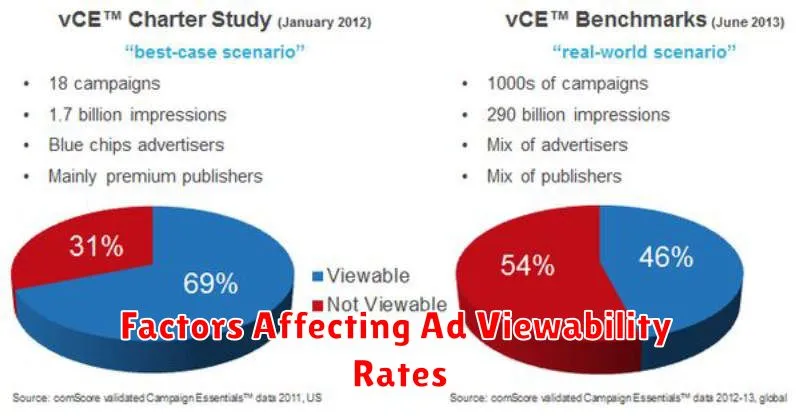In the dynamic realm of digital advertising, ensuring that your ads are actually seen by your target audience is paramount for maximizing return on investment (ROI). This is where viewability metrics come into play. Understanding and effectively utilizing these metrics is no longer optional; it’s a critical component of any successful digital marketing strategy. This comprehensive guide will delve into the intricacies of viewability, providing you with the knowledge and tools necessary to decode these vital measurements and optimize your ad campaigns for enhanced performance. We will explore industry standards, different viewability vendors, and practical strategies for improving your viewability scores across various platforms.
This article, “Decoding Viewability Metrics: A Comprehensive Guide to Understanding and Optimizing Digital Ad Performance,” aims to demystify the complexities surrounding ad viewability. We will explore the key performance indicators (KPIs) such as viewable impressions, viewable rate, and active view time. By understanding these metrics, you can gain actionable insights into how users are interacting with your online advertisements, allowing you to make data-driven decisions to improve campaign effectiveness, reduce ad waste, and ultimately drive better results from your digital marketing investments. This guide is designed for marketers, advertisers, and anyone seeking to improve the performance of their digital advertising efforts.
What is Viewability in Digital Advertising?
In the realm of digital advertising, viewability refers to the ability of an ad to be seen by a real user. It’s not simply about whether an ad was served to a webpage, but whether a portion of it was actually visible within the user’s viewport.
More specifically, viewability ensures that an ad has the opportunity to make an impression. This contrasts with ads that are loaded on a page but are never scrolled into view, rendering them effectively unseen.
Understanding viewability is crucial for advertisers because it directly impacts the effectiveness of their campaigns. Paying for impressions that are never seen is a waste of resources. Viewability metrics provide insights into where ads are being displayed and whether they have a chance to capture the audience’s attention.
The IAB and MRC Viewability Standards
Establishing a standardized definition of viewability was crucial for the digital advertising industry. The Interactive Advertising Bureau (IAB) and the Media Rating Council (MRC) collaborated to set these standards.
The current standard, as defined by the IAB and MRC, states that for a display ad to be considered viewable, 50% of the ad’s pixels must be in view for a minimum of one second. For large display ads (defined as 242,500 pixels or greater), the minimum threshold remains 50% of the pixels in view, but the time requirement extends to two continuous seconds.
For video ads, the standard requires 50% of the ad’s pixels to be in view for a minimum of two continuous seconds. These standards provide a benchmark for measuring and ensuring that digital advertisements have a reasonable opportunity to be seen by consumers.
Key Viewability Metrics You Need to Know
Understanding viewability metrics is crucial for assessing the effectiveness of digital advertising campaigns. Here are some essential metrics to consider:
- Viewable Impressions: The number of ad impressions that meet the IAB and MRC standards for viewability.
- Viewability Rate: The percentage of ad impressions that were considered viewable out of the total impressions served. It is calculated as (Viewable Impressions / Total Impressions) * 100.
- Average Viewable Time: The average duration, in seconds, that a viewable ad impression remained in view.
- Above-the-Fold Viewability: Measures the viewability rate of ads placed in the “above-the-fold” section of a webpage, which is immediately visible without scrolling.
- In-View Time: The total time an ad is actually visible to the user.
Monitoring these metrics helps advertisers optimize their campaigns and ensure they are reaching their target audience.
Why is Viewability Important for Advertisers?
Viewability is crucial for advertisers because it directly impacts the effectiveness and return on investment (ROI) of their digital ad campaigns. If an ad is not seen, it cannot influence the target audience, rendering the ad spend wasted.
Here’s why viewability matters:
- Ensures Ad Exposure: Viewability guarantees that ads have the opportunity to be seen by real users, maximizing the potential for brand awareness and message delivery.
- Improved ROI: By focusing on viewable impressions, advertisers can optimize their ad spend and achieve a higher ROI. They are only paying for ads that have a chance to make an impact.
- Enhanced Brand Reputation: Placing ads in viewable environments demonstrates a commitment to quality and avoids association with potentially fraudulent or low-quality placements.
- Better Data and Insights: Viewability metrics provide more accurate data for analyzing campaign performance and making informed decisions about ad placement and targeting strategies.
Ultimately, prioritizing viewability is essential for advertisers seeking to achieve tangible results from their digital advertising efforts. By focusing on viewable impressions, advertisers can ensure that their ads are seen, their messages are heard, and their investments are maximized.
Factors Affecting Ad Viewability Rates

Ad viewability rates are influenced by a multitude of factors, spanning technical aspects, user behavior, and website design. Understanding these factors is crucial for optimizing ad campaigns.
Placement on the Page
The position of the ad unit on the page is paramount. Ads placed above the fold, meaning visible without scrolling, generally have higher viewability rates. Ads located lower on the page are more likely to be missed by users who do not scroll down.
Ad Format and Size
The size and format of the ad also play a significant role. Larger ad units and rich media formats tend to attract more attention and therefore have higher viewability. However, overly intrusive formats can negatively impact user experience.
Website Latency and Load Time
Slow website loading times can prevent ads from rendering correctly or appearing at all, significantly impacting viewability. Optimization of website performance is critical.
Ad Clutter
A webpage with excessive ads can distract users and lower the viewability of individual ads. A clean and focused layout generally leads to better results.
Browser and Device Compatibility
Ensuring ads are compatible across various browsers and devices is essential. Technical issues can prevent ads from displaying correctly on certain platforms.
How to Measure Viewability: Tools and Technologies
The measurement of viewability relies on specialized tools and technologies designed to track whether an ad meets the established criteria. These solutions typically involve embedding JavaScript code within the ad creative or page to monitor the ad’s presence within the user’s viewport.
Here are some common tools and technologies:
- Ad Servers: Platforms like Google Ad Manager and Xandr offer built-in viewability measurement capabilities.
- Verification Vendors: Companies like Integral Ad Science (IAS), DoubleVerify, and Moat provide independent, third-party viewability verification.
- Analytics Platforms: Solutions like Google Analytics can be integrated with ad platforms to provide insights into user engagement and viewability.
These tools generate reports that detail the viewability rate of ads, providing advertisers with critical data to assess campaign performance and optimize their media buys. Understanding the nuances of each platform is key to accurate and actionable insights.
Strategies for Improving Ad Viewability
Improving ad viewability is crucial for maximizing the return on investment (ROI) of digital advertising campaigns. Several strategies can be employed to enhance the likelihood that ads are seen by the target audience. These strategies focus on optimizing ad placement, ad format, and website design.
Optimize Ad Placement
Strategic ad placement is paramount. Placing ads above the fold ensures immediate visibility. Avoid placing ads in locations where users are unlikely to scroll or engage. Consider using heatmaps to understand user behavior and optimize accordingly.
Choose the Right Ad Formats
Select ad formats that are inherently more viewable. For instance, sticky ads or in-feed video ads tend to have higher viewability rates than traditional banner ads. Ensure that ad formats are responsive and compatible with various devices.
Enhance Website Design
Website design plays a significant role in ad viewability. Optimize page load speed, as slow loading times can cause ads to be skipped or missed. Ensure a clean and uncluttered layout that allows ads to be easily seen. Avoid excessive ad density, which can negatively impact user experience and viewability.
The Impact of Viewability on Campaign Performance
Viewability directly correlates with the success of digital advertising campaigns. Ads that are never seen have zero impact, regardless of their creative quality or targeting precision. By focusing on viewable impressions, advertisers can ensure their message has the opportunity to resonate with the intended audience.
Improved viewability leads to several positive outcomes:
- Increased Brand Awareness: Viewable ads contribute more effectively to brand recall and recognition.
- Higher Click-Through Rates (CTR): Users are more likely to click on ads they actually see.
- Improved Conversion Rates: Increased visibility can lead to a greater number of conversions and sales.
- Better Return on Ad Spend (ROAS): When ads are viewable, ad spend is used more efficiently, generating better returns.
Ultimately, prioritizing viewability is essential for maximizing the effectiveness and ROI of digital advertising campaigns.
Viewability vs. Other Ad Measurement Metrics
While viewability is a crucial metric, it’s essential to differentiate it from other ad measurement metrics. Understanding these distinctions allows for a more comprehensive evaluation of digital ad performance.
Here’s a brief comparison:
- Impressions: The number of times an ad is displayed, regardless of whether it was seen. Viewability builds upon impressions by determining if the ad was actually visible.
- Clicks: Indicate user engagement with the ad. A high click-through rate (CTR) suggests relevance, but doesn’t guarantee viewability. An ad can be viewed but not clicked, and vice versa.
- Reach: The number of unique users exposed to the ad. Viewability complements reach by ensuring those users actually saw the ad.
- Engagement: Measures user interaction beyond clicks, such as dwell time or video completion rate. These are indicative of user interest but rely on the ad being viewable in the first place.
- Conversion: Whether or not the user converted after seeing the ad. Viewability is important for attributing the conversion to the ad being seen.
In essence, viewability focuses on *whether* an ad was seen, while other metrics measure *what happened* after the ad was potentially seen. A holistic approach considers all these metrics for a complete picture of ad effectiveness.
The Future of Viewability Measurement

The landscape of viewability measurement is continuously evolving, driven by technological advancements and the need for greater accuracy and transparency in digital advertising. Emerging trends point towards a more granular and contextual understanding of ad exposure.
One key area of development is the integration of artificial intelligence (AI) and machine learning (ML). These technologies can analyze vast datasets to identify patterns and predict viewability with greater precision, taking into account factors like ad placement, user behavior, and device characteristics.
Another significant trend is the move towards cross-platform viewability. As consumers engage with content across various devices and channels, advertisers require unified measurement solutions that provide a holistic view of campaign performance. This includes addressing the challenges of viewability within emerging formats like connected TV (CTV) and in-app advertising.
Ultimately, the future of viewability measurement lies in creating a more reliable and comprehensive system that empowers advertisers to optimize their campaigns and maximize their return on investment. This requires ongoing collaboration between industry stakeholders to establish standardized metrics and promote transparency across the digital advertising ecosystem.

